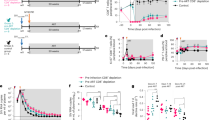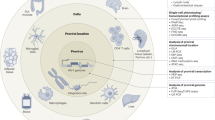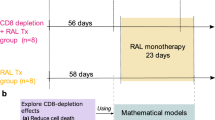Abstract
Cytotoxic T-lymphocyte (CTL) responses peak coincident with the decline in acute HIV viremia. Despite two reports of CTL-resistant HIV variants emerging during acute infection, the contribution of acute CTL escape to HIV pathogenesis remains unclear. Difficulties inherent in studying acute HIV infection can be overcome by modeling virus-host interactions in SIV-infected rhesus macaques. We sequenced 21 complete simian immunodeficiency virus (SIV)mac239 genomes at four weeks post-infection to determine the extent of acute CTL escape. Here we show that viruses from 19 of 21 macaques escaped from CTLs during acute infection and that these escape-selecting CTLs were responsive to lower concentrations of peptide than other SIV-specific CTLs. Interestingly, CTLs that require low peptide concentrations for stimulation (high 'functional avidity') are particularly effective at controlling other viral infections. Our results suggest that acute viral escape from CTLs is a hallmark of SIV infection and that CTLs with high functional avidity can rapidly select for escape variants.
This is a preview of subscription content, access via your institution
Access options
Subscribe to this journal
Receive 12 print issues and online access
$209.00 per year
only $17.42 per issue
Buy this article
- Purchase on Springer Link
- Instant access to full article PDF
Prices may be subject to local taxes which are calculated during checkout




Similar content being viewed by others
Accession codes
References
Koup, R.A. & Ho, D.D. Shutting down HIV. Nature 370, 416 (1994).
Koup, R.A. et al. Temporal association of cellular immune responses with the initial control of viremia in primary human immunodeficiency virus type 1 syndrome. J. Virol. 68, 4650–4655 (1994).
Reimann, K.A. et al. Immunopathogenic events in acute infection of rhesus monkeys with simian immunodeficiency virus of macaques. J. Virol. 68, 2362–2370 (1994).
Yasutomi, Y., Reimann, K.A., Lord, C.I., Miller, M.D. & Letvin, N.L. Simian immunodeficiency virus-specific CD8+ lymphocyte response in acutely infected rhesus monkeys. J. Virol. 67, 1707–1711 (1993).
Matano, T. et al. Administration of an anti-CD8 monoclonal antibody interferes with the clearance of chimeric simian/human immunodeficiency virus during primary infections of rhesus macaques. J. Virol. 72, 164–169 (1998).
Jin, X. et al. Dramatic rise in plasma viremia after CD8(+) T cell depletion in simian immunodeficiency virus-infected macaques. J. Exp. Med. 189, 991–998 (1999).
Schmitz, J.E. et al. Control of viremia in simian immunodeficiency virus infection by CD8(+) lymphocytes. Science 283, 857–860 (1999).
McMichael, A.J. & Rowland-Jones, S.L. Cellular immune responses to HIV. Nature 410, 980–987 (2001).
Day, C.L. et al. Relative dominance of epitope-specific cytotoxic T-lymphocyte responses in human immunodeficiency virus type 1-infected persons with shared HLA alleles. J. Virol. 75, 6279–6291 (2001).
Rowland-Jones, S.L. et al. How important is the 'quality' of the cytotoxic T lymphocyte (CTL) response in protection against HIV infection? Immunol. Lett 79, 15–20 (2001).
Kaul, R. et al. CD8(+) lymphocytes respond to different HIV epitopes in seronegative and infected subjects. J. Clin Invest 107, 1303–1310 (2001).
Kuroda, M.J. et al. Comparative analysis of cytotoxic T lymphocytes in lymph nodes and peripheral blood of simian immunodeficiency virus-infected rhesus monkeys. J. Virol. 73, 1573–1579 (1999).
Allen, T.M. et al. Tat-specific cytotoxic T lymphocytes select for SIV escape variants during resolution of primary viraemia. Nature 407, 386–390 (2000).
Goulder, P.J. et al. Substantial differences in specificity of HIV-specific cytotoxic T cells in acute and chronic HIV infection. J. Exp Med. 193, 181–194 (2001).
Kaul, R. et al. Late seroconversion in HIV-resistant Nairobi prostitutes despite pre-existing HIV-specific CD8+ responses. J. Clin Invest 107, 341–349 (2001).
Kaul, R. et al. New insights into HIV-1 specific cytotoxic T-lymphocyte responses in exposed, persistently seronegative Kenyan sex workers. Immunol. Lett 79, 3–13 (2001).
Van Baalen, C.A. et al. Kinetics of antiviral activity by human immunodeficiency virus type 1-specific cytotoxic T lymphocytes (CTL) and rapid selection of CTL escape virus in vitro. J. Virol. 72, 6851–6857 (1998).
Goulder, P.J. et al. Late escape from an immunodominant cytotoxic T-lymphocyte response associated with progression to AIDS. Nature Med. 3, 212–217 (1997).
Mortara, L. et al. Selection of virus variants and emergence of virus escape mutants after immunization with an epitope vaccine. J. Virol. 72, 1403–1410 (1998).
Wilson, C.C. et al. Frequent detection of escape from cytotoxic T-lymphocyte recognition in perinatal human immunodeficiency virus (HIV) type 1 transmission: the ariel project for the prevention of transmission of HIV from mother to infant. J. Virol. 73, 3975–3985 (1999).
Soudeyns, H. et al. Selective pressure exerted by immunodominant HIV-1-specific cytotoxic T lymphocyte responses during primary infection drives genetic variation restricted to the cognate epitope. Eur J. Immunol. 29, 3629–3635 (1999).
Evans, D.T. et al. Virus-specific cytotoxic T-lymphocyte responses select for amino-acid variation in simian immunodeficiency virus Env and Nef. Nature Med. 5, 1270–1276 (1999).
Chen, Z.W. et al. Simian immunodeficiency virus evades a dominant epitope-specific cytotoxic T lymphocyte response through a mutation resulting in the accelerated dissociation of viral peptide and MHC class I. J. Immunol. 164, 6474–6479 (2000).
Wolinsky, S.M. et al. Adaptive evolution of human immunodeficiency virus-type 1 during the natural course of infection. Science 272, 537–542 (1996).
Price, D.A. et al. Positive selection of HIV-1 cytotoxic T lymphocyte escape variants during primary infection. Proc. Natl. Acad. Sci. USA 94, 1890–1895 (1997).
Borrow, P. et al. Antiviral pressure exerted by HIV-1-specific cytotoxic T lymphocytes (CTLs) during primary infection demonstrated by rapid selection of CTL escape virus. Nature Med. 3, 205–211 (1997).
Slifka, M.K. & Whitton, J.L. Functional avidity maturation of CD8(+) T cells without selection of higher affinity TCR. Nature Immunol. 2, 711–717 (2001).
Derby, M., Alexander-Miller, M., Tse, R. & Berzofsky, J. High-avidity CTL exploit two complementary mechanisms to provide better protection against viral infection than low-avidity CTL. J. Immunol. 166, 1690–1697 (2001).
Alexander-Miller, M.A., Leggatt, G.R. & Berzofsky, J.A. Selective expansion of high- or low-avidity cytotoxic T lymphocytes and efficacy for adoptive immunotherapy. Proc. Natl. Acad. Sci. USA 93, 4102–4107 (1996).
Alexander, L., Denekamp, L., Czajak, S. & Desrosiers, R.C. Nucleotides in the Infectious, Pathogenic Simian Immunodeficiency Virus Clone SIVmac239. J. Virol. 75, 4019–4022 (2001).
Robinson, S. et al. A commonly recognized simian immunodeficiency virus nef epitope presented to cytotoxic T lymphocytes of indian-origin rhesus monkeys by the prevalent major histocompatibility complex class I allele mamu-a*02. J. Virol. 75, 10179–10186 (2001).
Derby, M.A., Alexander-Miller, M.A., Tse, R. & Berzofsky, J.A. High-avidity CTL exploit two complementary mechanisms to provide better protection against viral infection than low-avitity CTL. J. Immunol. 166, 1690–1697 (2001).
Gallimore, A., Dumrese, T., Hengartner, H., Zinkernagel, R.M. & Rammensee, H.G. Protective immunity does not correlate with the hierarchy of virus-specific cytotoxic T cell responses to naturally processed peptides. J. Exp. Med. 187, 1647–1657 (1998).
Gray, P.M., Parks, G.D. & Alexander-Miller, M.A. A novel CD8-independent high-avidity cytotoxic T-lymphocyte response directed against an epitope in the phosphoprotein of the paramyxovirus simian virus 5. J. Virol. 75, 10065–10072 (2001).
Allen, T.M. et al. CD8+ lymphocytes from simian immunodeficiency virus-infected rhesus macaques recognize 14 different epitopes bound by the major histocompatibility complex class I molecule Mamu-A*01: Implications for vaccine design and testing. J. Virol. 75, 738–749 (2001).
Vidal, C. et al. Lack of evidence of a stable viral load set-point in early stage asymptomatic patients with chronic HIV-1 infection. AIDS 12, 1285–9 (1998).
Mellors, J.W. et al. Quantitation of HIV-1 RNA in plasma predicts outcome after seroconversion. Ann. Intern. Med. 122, 573–579 (1995).
Mellors, J.W. et al. Prognosis in HIV-1 infection predicted by the quantity of virus in plasma. Science 272, 1167–1170 (1996).
Cooper, S. et al. Analysis of a successful immune response against hepatitis C virus. Immunity 10, 439–449 (1999).
Goulder, P.J. et al. Evolution and transmission of stable CTL escape mutations in HIV infection. Nature 412, 334–338 (2001).
Knapp, L.A., Lehmann, E., Piekarczyk, M.S., Urvater, J.A. & Watkins, D.I. A high frequency of Mamu-A*01 in the rhesus macaque detected by polymerase chain reaction with sequence-specific primers and direct sequencing. Tissue Antigens 50, 657–661 (1997).
Allen, T. et al. Tat vaccinated macaques do not control simian immunodeficiency virus SIVmac239 replication. J. Virol. 76, 4108–4112 (2002).
Allen, T.M. et al. Induction of AIDS virus-specific CTL activity in fresh, unstimulated peripheral blood lymphocytes from rhesus macaques vaccinated with a DNA prime/modified vaccinia virus Ankara boost regimen. . Immunol. 164, 4968–4978 (2000).
Trivedi, P. et al. Intrarectal transmission of simian immunodeficiency virus in rhesus macaques: selective amplification and host responses to transient or persistent viremia. J. Virol. 70, 6876–6883 (1996).
Regier, D.A. & Desrosiers, R.C. The complete nucleotide sequence of a pathogenic molecular clone of simian immunodeficiency virus. AIDS Res. Hum. Retroviruses 6, 1221–1231 (1990).
Allen, T.M. et al. Characterization of the peptide binding motif of a rhesus MHC class I molecule (Mamu-A*01) that binds an immunodominant CTL epitope from simian immunodeficiency virus. J. Immunol. 160, 6062–6071 (1998).
Allen, T.M. et al. CD8(+) lymphocytes from simian immunodeficiency virus-infected rhesus macaques recognize 14 different epitopes bound by the major histocompatibility complex class I molecule mamu-A*01: Implications for vaccine design and testing. J. Virol. 75, 738–749 (2001).
Nei, M. & Gojobori, T. Simple methods for estimating the numbers of synonymous and nonsynonymous nucleotide substitutions. Mol. Biol. Evol. 3, 418–426 (1986).
Nei, M. & Jin, L. Variances of the average numbers of nucleotide substitutions within and between populations. Mol. Biol. Evol. 6, 290–300 (1989).
Acknowledgements
This study was supported by NIH grants AI49120, AI 46366, RR15371 and RR0167. D.I.W. is an Elizabeth Glaser Scientist.
Author information
Authors and Affiliations
Corresponding author
Ethics declarations
Competing interests
The authors declare no competing financial interests.
Rights and permissions
About this article
Cite this article
O'Connor, D., Allen, T., Vogel, T. et al. Acute phase cytotoxic T lymphocyte escape is a hallmark of simian immunodeficiency virus infection. Nat Med 8, 493–499 (2002). https://doi.org/10.1038/nm0502-493
Received:
Accepted:
Issue Date:
DOI: https://doi.org/10.1038/nm0502-493
This article is cited by
-
CD8+ lymphocytes do not impact SIV reservoir establishment under ART
Nature Microbiology (2023)
-
Immune escape mutations in HIV-1 controllers in the Brazilian Amazon region
BMC Infectious Diseases (2020)
-
Therapeutic vaccine-mediated Gag-specific CD8+ T-cell induction under anti-retroviral therapy augments anti-virus efficacy of CD8+ cells in simian immunodeficiency virus-infected macaques
Scientific Reports (2020)
-
Immune Signature of Enhanced Functional Avidity CD8+ T Cells in vivo Induced by Vaccinia Vectored Vaccine
Scientific Reports (2017)
-
Stem memory T cells (TSCM)—their role in cancer and HIV immunotherapies
Clinical & Translational Immunology (2014)



